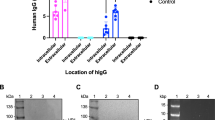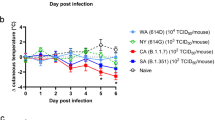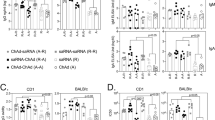Abstract
Simian adeno-associated virus (AAV) serotype rh.10 is a promising gene therapy tool, achieving safe, sustained transgene expression in the nervous system, lung, liver and heart in animal models. To date, preexisting immunity in humans has not been confirmed, though exposure is unexpected. We compared the humoral immune response with serotypes AAVrh.10 and AAV9 in mice, and AAVrh.10, AAV9 and AAV2 in 100 healthy humans. Mice, injected-intravenously, raised significantly more anti-AAV9 than anti-AAVrh.10 IgG (immunoglobulins), and sera demonstrated greater neutralizing capacity, correspondingly. Antibody cross-binding studies in mice showed negligible cross-recognition between AAVrh.10, AAV9 and AAV2. In humans, IgG prevalence against the most common human serotype, AAV2, was 72%; AAV9, 47% and AAVrh.10, a surprising, 59%. Yet, neutralizing-antibody seroprevalences were 71% for AAV2, 18% for AAV9 and 21% for AAVrh.10. Thus, most anti-AAV9 and anti-AAVrh.10 IgG were nonneutralizing. Indeed, sera generally neutralized AAV2 more strongly than AAVrh.10. Further, all samples neutralizing AAVrh.10 or AAV9 also neutralized AAV2, suggesting antibody cross-recognition. This contrasts with the results in mice, and highlights the complexity of tailoring gene therapy to minimize the immune response in humans, when multiple-mixed infections during a lifetime evoke a broad repertoire of preexisting antibodies capable of cross reacting with non-human serotypes.
This is a preview of subscription content, access via your institution
Access options
Subscribe to this journal
Receive 12 print issues and online access
$259.00 per year
only $21.58 per issue
Buy this article
- Purchase on Springer Link
- Instant access to full article PDF
Prices may be subject to local taxes which are calculated during checkout


Similar content being viewed by others
References
Mingozzi F, High KA . Immune responses to AAV vectors: overcoming barriers to successful gene therapy. Blood 2013; 122: 23–36.
Calcedo R, Wilson JM . Humoral immune response to AAV. Front Immunol 2013; 4: 341.
Mays LE, Vandenberghe LH, Xiao R, Bell P, Nam HJ, Agbandje-McKenna M et al. Adeno-associated virus capsid structure drives CD4-dependent CD8+ T cell response to vector encoded proteins. J Immunol 2009; 182: 6051–6060.
Ciesielska A, Hadaczek P, Mittermeyer G, Zhou S, Wright JF, Bankiewicz KS et al. Cerebral infusion of AAV9 vector-encoding non-self proteins can elicit cell-mediated immune responses. Mol Ther 2013; 21: 158–166.
Samaranch L, San Sebastian W, Kells AP, Salegio EA, Heller G, Bringas JR et al. AAV9-mediated expression of a non-self protein in nonhuman primate central nervous system triggers widespread neuroinflammation driven by antigen-presenting cell transduction. Mol Ther 2014; 22: 329–337.
Grieger JC, Samulski RJ . Adeno-associated virus vectorology, manufacturing, and clinical applications. Methods Enzymol 2012; 507: 229–254.
Gao G, Alvira MR, Somanathan S, Lu Y, Vandenberghe LH, Rux JJ et al. Adeno-associated viruses undergo substantial evolution in primates during natural infections. Proc Natl Acad Sci USA 2003; 100: 6081–6086.
Sondhi D, Hackett NR, Peterson DA, Stratton J, Baad M, Travis KM et al. Enhanced survival of the LINCL mouse following CLN2 gene transfer using the rh.10 rhesus macaque-derived adeno-associated virus vector. Mol Ther 2007; 15: 481–491.
Piguet F, Sondhi D, Piraud M, Fouquet F, Hackett NR, Ahouansou O et al. Correction of brain oligodendrocytes by AAVrh.10 intracerebral gene therapy in metachromatic leukodystrophy mice. Hum Gene Ther 2012; 23: 903–914.
Homs J, Pages G, Ariza L, Casas C, Chillon M, Navarro X et al. Intrathecal administration of IGF-I by AAVrh10 improves sensory and motor deficits in a mouse model of diabetic neuropathy. Mol Ther Method Clin Dev 2014; 1: 7.
Wang H, Yang B, Qiu L, Yang C, Kramer J, Su Q et al. Widespread spinal cord transduction by intrathecal injection of rAAV delivers efficacious RNAi therapy for amyotrophic lateral sclerosis. Hum Mol Genet 2014; 23: 668–681.
Tardieu M, Zerah M, Husson B, de Bournonville S, Deiva K, Adamsbaum C et al. Intracerebral administration of adeno-associated viral vector serotype rh.10 carrying human SGSH and SUMF1 cDNAs in children with mucopolysaccharidosis type IIIA disease: results of a phase I/II trial. Hum Gene Ther 2014; 25: 506–516.
Perdomini M, Belbellaa B, Monassier L, Reutenauer L, Messaddeq N, Cartier N et al. Prevention and reversal of severe mitochondrial cardiomyopathy by gene therapy in a mouse model of Friedreich's ataxia. Nat Med 2014; 20: 542–547.
Boutin S, Monteilhet V, Veron P, Leborgne C, Benveniste O, Montus MF et al. Prevalence of serum IgG and neutralizing factors against adeno-associated virus (AAV) types 1, 2, 5, 6, 8, and 9 in the healthy population: implications for gene therapy using AAV vectors. Hum Gene Ther 2010; 21: 704–712.
Calcedo R, Vandenberghe LH, Gao G, Lin J, Wilson JM . Worldwide epidemiology of neutralizing antibodies to adeno-associated viruses. J Infect Dis 2009; 199: 381–390.
Homs J, Ariza L, Pages G, Udina E, Navarro X, Chillon M et al. Schwann cell targeting via intrasciatic injection of AAV8 as gene therapy strategy for peripheral nerve regeneration. Gene Ther 2011; 18: 622–630.
Foust KD, Nurre E, Montgomery CL, Hernandez A, Chan CM, Kaspar BK . Intravascular AAV9 preferentially targets neonatal neurons and adult astrocytes. Nat Biotechnol 2009; 27: 59–65.
Duque S, Joussemet B, Riviere C, Marais T, Dubreil L, Douar AM et al. Intravenous administration of self-complementary AAV9 enables transgene delivery to adult motor neurons. Mol Ther 2009; 17: 1187–1196.
Lieberman R, Stiffel C, Asofsky R, Mouton D, Biozzi G, Benacerraf B . Genetic factors controlling anti-sheep erythrocyte antibody response and immunoglobulin synthesis in backcross and F2 progeny of mice genetically selected for ‘high’ or ‘low’ antibody synthesis. J Exp Med 1972; 136: 790–798.
Chiuchiolo MJ, Kaminsky SM, Sondhi D, Hackett NR, Rosenberg JB, Frenk EZ et al. Intrapleural administration of an AAVrh.10 vector coding for human alpha1-antitrypsin for the treatment of alpha1-antitrypsin deficiency. Human gene therapy. Clin Dev 2013; 24: 161–173.
Gray SJ, Nagabhushan Kalburgi S, McCown TJ, Jude Samulski R . Global CNS gene delivery and evasion of anti-AAV-neutralizing antibodies by intrathecal AAV administration in non-human primates. Gene Ther 2013; 20: 450–459.
Samaranch L, Salegio EA, San Sebastian W, Kells AP, Foust KD, Bringas JR et al. Adeno-associated virus serotype 9 transduction in the central nervous system of nonhuman primates. Hum Gene Ther 2012; 23: 382–389.
Riviere C, Danos O, Douar AM . Long-term expression and repeated administration of AAV type 1, 2 and 5 vectors in skeletal muscle of immunocompetent adult mice. Gene Ther 2006; 13: 1300–1308.
Gurda BL, DiMattia MA, Miller EB, Bennett A, McKenna R, Weichert WS et al. Capsid antibodies to different adeno-associated virus serotypes bind common regions. J Virol 2013; 87: 9111–9124.
Tellez J, Van Vliet K, Tseng YS, Finn JD, Tschernia N, Almeida-Porada G et al. Characterization of naturally-occurring humoral immunity to AAV in sheep. PLoS One 2013; 8: e75142.
Bartel M, Schaffer D, Buning H . Enhancing the clinical potential of AAV vectors by capsid engineering to evade pre-existing immunity. Front Microbiol 2011; 2: 204.
Louis Jeune V, Joergensen JA, Hajjar RJ, Weber T . Pre-existing anti-adeno-associated virus antibodies as a challenge in AAV gene therapy. Hum Gene Ther Methods 2013; 24: 59–67.
Calcedo R, Morizono H, Wang L, McCarter R, He J, Jones D et al. Adeno-associated virus antibody profiles in newborns, children, and adolescents. Clin Vaccine Immunol 2011; 18: 1586–1588.
Wang L, Calcedo R, Wang H, Bell P, Grant R, Vandenberghe LH et al. The pleiotropic effects of natural AAV infections on liver-directed gene transfer in macaques. Mol Ther 2010; 18: 126–134.
Zolotukhin S . Production of recombinant adeno-associated virus vectors. Hum Gene Ther 2005; 16: 551–557.
Zolotukhin S, Byrne BJ, Mason E, Zolotukhin I, Potter M, Chesnut K et al. Recombinant adeno-associated virus purification using novel methods improves infectious titer and yield. Gene Ther 1999; 6: 973–985.
Treleaven CM, Tamsett TJ, Bu J, Fidler JA, Sardi SP, Hurlbut GD et al. Gene transfer to the CNS is efficacious in immune-primed mice harboring physiologically relevant titers of anti-AAV antibodies. Mol Ther 2012; 20: 1713–1723.
Acknowledgements
We thank the Vector Production Unit at CBATEG (Universitat Autònoma de Barcelona) for producing AAV vectors, the LLEB (UAB) for the luminescence measurements, Dr James M. Wilson (University of Pennsylvania) for providing AAV9 and AAVrh.10 RepCap plasmids and Dr Lorena Ariza (CBATEG, UAB) for experimental advice. We are also grateful to the Catalan Banc de Sang i Teixits (BST) for the human samples. GP was recipient of predoctoral fellowship from the Generalitat de Catalunya (2009FI_B00219). This work was supported by the Generalitat de Catalunya (2014 SGR 1354), the Instituto de Salud Carlos III (PS09720) and the Marató TV3 (110432) to AB.
Author information
Authors and Affiliations
Corresponding author
Ethics declarations
Competing interests
The authors declare no conflict of interest.
Additional information
Supplementary Information accompanies this paper on Gene Therapy website
Rights and permissions
About this article
Cite this article
Thwaite, R., Pagès, G., Chillón, M. et al. AAVrh.10 immunogenicity in mice and humans. Relevance of antibody cross-reactivity in human gene therapy. Gene Ther 22, 196–201 (2015). https://doi.org/10.1038/gt.2014.103
Received:
Revised:
Accepted:
Published:
Issue Date:
DOI: https://doi.org/10.1038/gt.2014.103
This article is cited by
-
Intracerebral lentiviral ABCD1 gene therapy in an early disease onset ALD mouse model
Gene Therapy (2023)
-
Validation of Anti-Adeno Associated Virus Serotype rh10 (AAVrh.10) Total and Neutralizing Antibody Immunogenicity Assays
Pharmaceutical Research (2023)
-
Efficacy of AAV serotypes to target Schwann cells after intrathecal and intravenous delivery
Scientific Reports (2021)
-
Adeno-associated virus-binding antibodies detected in cats living in the Northeastern United States lack neutralizing activity
Scientific Reports (2020)
-
Cerebellar Astrocyte Transduction as Gene Therapy for Megalencephalic Leukoencephalopathy
Neurotherapeutics (2020)



